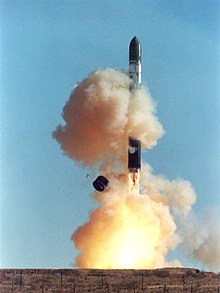
An intercontinental ballistic missile (ICBM) is a ballistic missile with a range greater than 5,500 kilometres (3,400 mi), primarily designed for nuclear weapons delivery. Conventional, chemical, and biological weapons can also be delivered with varying effectiveness, but have never been deployed on ICBMs. Most modern designs support multiple independently targetable reentry vehicle (MIRVs), allowing a single missile to carry several warheads, each of which can strike a different target. The United States, Russia, China, France, India, the United Kingdom, Israel, and North Korea are the only countries known to have operational ICBMs.

In nuclear strategy, a first strike or preemptive strike is a preemptive surprise attack employing overwhelming force. First strike capability is a country's ability to defeat another nuclear power by destroying its arsenal to the point where the attacking country can survive the weakened retaliation while the opposing side is left unable to continue war. The preferred methodology is to attack the opponent's strategic nuclear weapon facilities, command and control sites, and storage depots first. The strategy is called counterforce.

The Strategic Rocket Forces of the Russian Federation or the Strategic Missile Forces of the Russian Federation is a separate-troops branch of the Russian Armed Forces that controls Russia's land-based intercontinental ballistic missiles (ICBMs). It was formerly part of the Soviet Armed Forces from 1959 to 1991.

START II was a bilateral treaty between the United States and Russia on the Reduction and Limitation of Strategic Offensive Arms. It was signed by US President George H. W. Bush and Russian President Boris Yeltsin on 3 January 1993, banning the use of multiple independently targetable re-entry vehicles (MIRVs) on intercontinental ballistic missiles (ICBMs). Hence, it is often cited as the De-MIRV-ing Agreement.
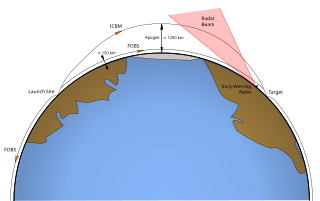
A Fractional Orbital Bombardment System (FOBS) is a warhead delivery system that uses a low Earth orbit towards its target destination. Just before reaching the target, it deorbits through a retrograde engine burn.

The RT-2PM2 «Topol-M» is one of the most recent intercontinental ballistic missiles to be deployed by Russia, and the first to be developed after the dissolution of the Soviet Union. It was developed from the RT-2PM Topol mobile intercontinental ballistic missile.
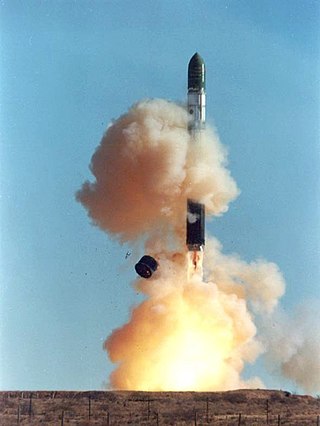
The R-36 is a family of intercontinental ballistic missiles (ICBMs) and space launch vehicles (Tsyklon) designed by the Soviet Union during the Cold War. The original R-36 was deployed under the GRAU index 8K67 and was given the NATO reporting name SS-9 Scarp. It was able to carry three warheads and was the first Soviet MRV missile. The later version, the R-36M, also known as RS20, was produced under the GRAU designations 15A14 and 15A18 and was given the NATO reporting name SS-18 Satan. This missile was viewed by certain United States analysts as giving the Soviet Union first strike advantage over the U.S., particularly because of its rapid silo-reload ability, very heavy throw weight and extremely large number of re-entry vehicles. Some versions of the R-36M were deployed with 10 warheads and up to 40 penetration aids and the missile's high throw-weight made it theoretically capable of carrying more warheads or penetration aids. Contemporary U.S. missiles, such as the Minuteman III, carried up to three warheads at most.

The RT-2PM Topol was a mobile intercontinental ballistic missile designed in the Soviet Union and in service with Russia's Strategic Missile Troops. As of 2014, Russia planned to replace all RT-2PM ICBMs with versions of Topol-M. In December 2023, last Topol regiment was taken off combat duty.
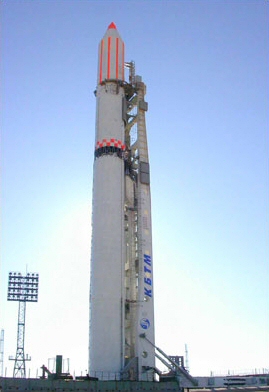
Pivdenmash, formerly known as Yuzhmash, meaning Southern Engineering, is a Ukrainian state-owned aerospace manufacturer. It was formerly a Soviet state-owned factory prior to 1991.

The R-9 was a two-stage IRBM of the Soviet Union, in service from 1964 to 1976.
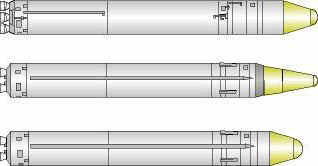
The UR-100N, also known as RS-18A, is an intercontinental ballistic missile in service with Soviet and Russian Strategic Missile Troops. The missile was given the NATO reporting name SS-19 Stiletto and carries the industry designation 15A30.
The UR-200 was an intercontinental ballistic missile (ICBM) developed by Vladimir Chelomey's OKB-52 in the Soviet Union. It was known during the Cold War by the NATO reporting name SS-10 Scrag and internally by the GRAU index 8K81. The design was authorized by the Decisions of the Central Committee of the CPSU of March 16 and August 1, 1961, and the draft project was finished in July 1962. It first flew on November 4, 1963, from the Baikonur Cosmodrome. The ninth and final flight was conducted on October 20, 1964.

A nuclear triad is a three-pronged military force structure of land-based intercontinental ballistic missiles (ICBMs), submarine-launched ballistic missiles (SLBMs), and strategic bombers with nuclear bombs and missiles. Countries build nuclear triads to eliminate an enemy's ability to destroy a nation's nuclear forces in a first-strike attack, which preserves their own ability to launch a second strike and therefore increases their nuclear deterrence.

The RS-24 Yars also known as Topol-MR, NATO reporting name SS-29 or SS-27 Mod 2), is a Russian MIRV-equipped, thermonuclear armed intercontinental ballistic missile first tested on May 29, 2007, after a secret military R&D project.
The RS-28 Sarmat, often unofficially called Satan II by some media outlets, is a Russian liquid-fueled, MIRV-equipped super-heavy intercontinental ballistic missile (ICBM) produced by the Makeyev Rocket Design Bureau. It is intended to replace the R-36M ICBM in Russia's arsenal.
The RS-27 (?) or SS-X-32Zh (?) Barguzin BZhRK (БЖРК) Project is a rail-mobile intercontinental ballistic missile (ICBM) under development for the Russian RVSN, as a replacement of the previous railway missile train Molodets BZhRK SS-24 Scalpel. BZhRK stands for railway strategic missile train. The missile was expected to enter testing in 2019 and enter service in 2020.
The 46th Nizhnedneprovskaya Order of the October Revolution Red Banner Rocket Division / Missile Division was a division of the Soviet Strategic Rocket Forces, active from 1961–62 to 1992 under the Soviet Union, and from 1992 to 2002 as part of Ukraine. The division traced its history back to the 188th Rifle Division, formed in Kaunas in spring 1941. The division fought in the Battle of the Dnieper, for which it was awarded the honorific "Lower Dnieper". After the Second Jassy–Kishinev Offensive it garrisoned Sliven in Bulgaria. At some point it moved to Pervomaisk in the then-Ukrainian SSR and became the 20th Rifle Division in 1955. In 1957, it became the 93rd Motor Rifle Division and was disbanded in 1959. In 1960, the 29th Rocket Brigade was formed in Pervomaisk and became the 46th Rocket Division in 1960. The 46th Rocket Division inherited the honors and awards of the 188th Rifle Division. After the dissolution of the Soviet Union, the division became part of Ukrainian military and was disbanded by 2002.

The Avangard is a Russian hypersonic glide vehicle (HGV) that can be carried as a MIRV payload by the UR-100UTTKh, R-36M2 and RS-28 Sarmat heavy ICBMs. It can deliver both nuclear and conventional payloads.
